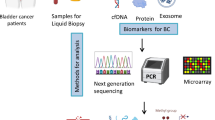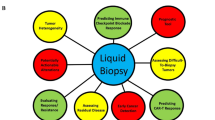Abstract
Among gynaecological cancers, epithelial ovarian cancers are the most deadly cancers while endometrial cancers are the most common diseases. Efforts to establish relevant novel diagnostic, screening and prognostic markers are aimed to help reduce the high level of mortality, chemoresistance and recurrence, particularly in ovarian cancer. MicroRNAs, the class of post-transcriptional regulators, have emerged as the promising diagnostic and prognostic markers associated with various diseased states recently. Urine has been shown as the source of microRNAs several years ago; however, there has been lack of information on urine microRNA expression in ovarian and endometrial cancers till now. In this pilot study, we examined the expression of candidate cell-free urine microRNAs in ovarian cancer and endometrial cancer patients using quantitative real-time PCR. We compared the expression between pre- and post-surgery ovarian cancer samples, and between patients with ovarian and endometrial cancers and healthy controls, within three types of experiments. These experiments evaluated three different isolation methods of urine RNA, representing two supernatant and one exosome fractions of extracellular microRNA. In ovarian cancer, we found miR-92a significantly up-regulated, and miR-106b significantly down-regulated in comparison with control samples. In endometrial cancer, only miR-106b was found down-regulated significantly compared to control samples. Using exosome RNA, no significant de-regulations in microRNAs expression could be found in either of the cancers investigated. We propose that more research should now focus on confirming the diagnostic potential of urine microRNAs in gynaecological cancers using more clinical samples and large-scale expression profiling methods.
Similar content being viewed by others
References
Siegel R, Ma J, Zou Z, Jemal A (2014) Cancer statistics, 2014. Ca-Cancer J Clin 64:9–29. doi:10.3322/caac.21208
Howlader N, Noone AM, Krapcho M et al. (eds) (2013) SEER Cancer Statistics Review, 1975–2010, National Cancer Institute. Bethesda, MD. [http://seer.cancer.gov/csr/1975_2010/, based on November 2012 SEER data submission, posted to the SEER web site, April 2013].
Zavesky L, Jancarkova N, Kohoutova M (2011) Ovarian cancer: origin and factors involved in carcinogenesis with potential use in diagnosis, treatment and prognosis of the disease. Neoplasma 58:457–468. doi:10.4149/neo_2011_06_457
Devor EJ, Hovey AM, Goodheart MJ et al (2011) microRNA expression profiling of endometrial endometrioid adenocarcinomas and serous adenocarcinomas reveals profiles containing shared, unique and differentiating groups of microRNAs. Oncol Rep 26:995–1002. doi:10.3892/or.2011.1372
Banno K, Nogami Y, Kisu I et al (2013) Candidate biomarkers for genetic and clinicopathological diagnosis of endometrial cancer. Int J Mol Sci 14(6):12123–12137. doi:10.3390/ijms140612123
Iorio MV, Croce CM (2012) MicroRNA dysregulation in cancer: diagnostics, monitoring and therapeutics. A comprehensive review. EMBO Mol Med 4:143–159. doi:10.1002/emmm.201100209
Zhao YN, Chen GS, Hong SJ (2014) Circulating MicroRNAs in gynecological malignancies: from detection to prediction. Exp Hematol Oncol 3:14. doi:10.1186/2162-3619-3-14
Weber JA, Baxter DH, Zhang SL et al (2010) The MicroRNA Spectrum in 12 Body Fluids. Clin Chem (Washington, DC, U S) 56:1733–1741. doi:10.1373/clinchem.2010.147405
Yamada Y, Enokida H, Kojima S et al (2011) MiR-96 and miR-183 detection in urine serve as potential tumor markers of urothelial carcinoma: correlation with stage and grade, and comparison with urinary cytology. Cancer Sci 102:522–529. doi:10.1111/j.1349-7006.2010.01816.x
Bryant RJ, Pawlowski T, Catto JWF et al (2012) Changes in circulating microRNA levels associated with prostate cancer. Br J Cancer 106:768–774. doi:10.1038/bjc.2011.595
Mengual L, Loyano JJ, Ingelmo-Torres M et al (2013) Using microRNA profiling in urine samples to develop a non-invasive test for bladder cancer. Int J Cancer 133(11):2631–2641. doi:10.1002/ijc.28274
Hanke M, Hoefig K, Merz H et al (2010) A robust methodology to study urine microRNA as tumor marker: microRNA-126 and microRNA-182 are related to urinary bladder cancer. Urol Oncol Semin Orig Invest 28:655–661. doi:10.1016/j.urolonc.2009.01.027
Haj-Ahmad TA, Abdalla MAK, Haj-Ahmad Y (2014) Potential urinary miRNA biomarker candidates for the accurate detection of prostate cancer among benign prostatic hyperplasia patients. J Cancer 5(3):182–191. doi:10.7150/jca.6799
Wang G, Chan ESY, Kwan BCH et al (2012) Expression of microRNAs in the urine of patients with bladder cancer. Clin Genitourin Cancer 10(2):106–113. doi:10.1016/j.clgc.2012.01.001
Zhao S, Fernald RD (2005) Comprehensive algorithm for quantitative real-time polymerase chain reaction. J Comput Biol 12:1047–1064. doi:10.1089/cmb.2005.12.1047
Guescini M, Sisti D, Rocchi MBL et al (2008) A new real-time PCR method to overcome significant quantitative inaccuracy due to slight amplification inhibition. BMC Bioinf 9:326. doi:10.1186/1471-2105-9-326
Pfaffl MW, Tichopad A, Prgomet C, Neuvians TP (2004) Determination of stable housekeeping genes, differentially regulated target genes and sample integrity: BestKeeper - excel-based tool using pair-wise correlations. Biotechnol Lett 26:509–515. doi:10.1023/B:BILE.0000019559.84305.47
Andersen CL, Jensen JL, Ørntoft TF (2004) Normalization of real-time quantitative reverse transcription-PCR data: a model-based variance estimation approach to identify genes suited for normalization, applied to bladder and colon cancer data sets. Cancer Res 64:5245–5250. doi:10.1158/0008-5472.CAN-04-0496
Wyman SK, Parkin RK, Mitchell PS et al (2009) Repertoire of microRNAs in epithelial ovarian cancer as determined by next generation sequencing of small RNA cDNA libraries. Plos One 4:e5311. doi:10.1371/journal.pone.0005311
Resnick KE, Alder H, Hagan JP et al (2009) The detection of differentially expressed microRNAs from the serum of ovarian cancer patients using a novel real-time PCR platform. Gynecol Oncol 112:55–59. doi:10.1016/j.ygyno.2008.08.036
Dahiya N, Sherman-Baust CA, Wang TL et al (2008) MicroRNA expression and identification of putative miRNA targets in ovarian cancer. Plos One 3(6):e2436. doi:10.1371/journal.pone.0002436
Hausler SFM, Keller A, Chandran PA et al (2010) Whole blood-derived miRNA profiles as potential new tools for ovarian cancer screening. Br J Cancer 103:693–700. doi:10.1038/sj.bjc.6605833
Shapira I, Oswald M, Lovecchio J et al (2014) Circulating biomarkers for detection of ovarian cancer and predicting cancer outcomes. Br J Cancer 110:976–983. doi:10.1038/bjc.2013.795
Laios A, O’Toole S, Flavin R et al (2008) Potential role of miR-9 and miR-223 in recurrent ovarian cancer. Mol Cancer 7:35. doi:10.1186/1476-4598-7-35
Dong P, Kaneuchi M, Watari H et al (2014) MicroRNA-106b modulates epithelial-mesenchymal transition by targeting TWIST1 in invasive endometrial cancer cell lines. Mol Carcinog 53:349–359. doi:10.1002/mc.21983
Ni X, Xia T, Zhao T et al (2014) Downregulation of miR-106b induced breast cancer cell invasion and motility in association with overexpression of matrix metalloproteinase 2. Cancer Sci 105:18–25. doi:10.1111/cas.12309
Hiroki E, Akahira J, Suzuki F et al (2010) Changes in microRNA expression levels correlate with clinicopathological features and prognoses in endometrial serous adenocarcinomas. Cancer Sci 101:241–249. doi:10.1111/j.1349-7006.2009.01385.x
Kan CWS, Hahn MA, Gard GB et al (2012) Elevated levels of circulating microRNA-200 family members correlate with serous epithelial ovarian cancer. BMC Cancer 12:627. doi:10.1186/1471-2407-12-627
Acknowledgments
We are very grateful to Petra Soukupová, M.D., Laura Sucharovová, M.D. and Veronika Hanzíková, M.D. (Transfusion Department, General University Hospital Prague) involved in control patients sampling. We also thank Marta Číhalová, M.D. participating in sampling in FN Brno. We thank Jitka Pavlíková (FN Brno), Stanislava Štursová and Martina Vinopalová (Institute of the Care of Mother and Child Prague) ensuring samples collection. We are very grateful to Markéta Tesařová, Ph.D. (Department of Pediatrics and Adolescent Medicine 1. LF UK and VFN) allowing to analyse samples on Agilent 2100 Bioanalyzer. Performing Cy0 analyses by Cy0 team (www.cy0method.org) is greatly acknowledged, namely we thank Renato Panebianco for his kind cooperation. The financial support from the Charles University Prague (project PRVOUK-P27/LF1/1) is also greatly appreciated. Clinical part in FN Brno was supported by Ministry of Health of the Czech Republic – project FNBr 65269705.
Conflict of interest
The authors declare that they have no conflict of interest.
Author information
Authors and Affiliations
Corresponding author
Rights and permissions
About this article
Cite this article
Záveský, L., Jandáková, E., Turyna, R. et al. Evaluation of Cell-Free Urine microRNAs Expression for the Use in Diagnosis of Ovarian and Endometrial Cancers. A Pilot Study. Pathol. Oncol. Res. 21, 1027–1035 (2015). https://doi.org/10.1007/s12253-015-9914-y
Received:
Accepted:
Published:
Issue Date:
DOI: https://doi.org/10.1007/s12253-015-9914-y




